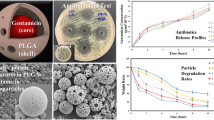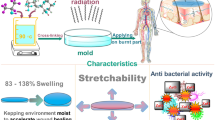Ceftriaxone is a third-generation antibiotic which has a broad spectrum of activity against Gram-positive and Gram-negative microorganisms. Normally, microorganisms that are present in wounds include S. aureus. P. aeruginosa, P. mirabilis, and E. coli, which do not allow tissues to regenerate. This work was aimed at develo** a spectrophotometric method to determine ceftriaxone loaded in polymeric microneedles for the treatment of chronic wounds. Regression equation of the method is linear in a concentration range of 16 – 48 μg/mL (correlation coefficient of 0.9998) at a selected detector wavelength of 274 nm. The detection and quantification limits are 2.57 × 10–3 and 8.59 × 10–3 μg/mL, respectively. The developed method demonstrated good inter-day and intra-day precision with an RSD < 2. The percentage recovery of ceftriaxone was 98.53%. In conclusion, the spectrophotometric method with detection at 274 nm is specific, reproducible, accurate and robust for the determination of ceftriaxone in polymeric microneedles of polymethyl vinyl ether-alt-maleic anhydride (PMVE/MA) at 95% confidence interval.



Similar content being viewed by others
References
N. A. Alhakamy, G. Caruso, B. Eid, et al., Pharmaceutics, 13(10), 3 – 19 (2021).
A. Takahiro, M. Daisuke, M. Takano, et al., IDSA, 73(8), 1452 – 1458 (2021).
C. Venturini, B. Bowring, A. Fajardo, et al., Antimicrob. Agents Chemother., 65(2), 1504 – 1520 (2021).
M. Kan, H. Y. Shi., B. Han, et al., Antimicrob. Agents Chemother., 65(1), 1 – 10 (2020).
M. A. Akl, M. A. Ahmed, A. Ramadan, et al., J. Pharm. Biomed., 55(2), 247 – 252 (2011).
A. Salman, Egypt. J. Chem., 64(9), 4901 – 4906 (2021).
K. Y. Patel, Z. R. Dedania, R. R. Dedania, FJPS, 7(1), 141 – 151 (2021).
M. T. da Trindade, A. C. Kogawa, H. R. Nunes, J. Chromatogr. Sci., 60(3) 1 – 7 (2021).
G. Pajchel, S. Tyski, J. Chromatogr. A, 895(1), 27 – 31 (2000).
M. Ongas, J. Standing, B. Ogutu, et al., Wellcome Open Res., 2(43), 1 – 34 (2017).
L. I. Bebawy, K. El Kelani, L. A. Fattah, et al., J. Pharm. Biomed., 32(6), 1219 – 1225 (2003).
J. Shah, M. R. Jan, S. Shah, et al., J. Fluoresc., 21(6), 2155 – 2163 (2011).
H. Assaf, B. Bushra, J. Pharm. and Tech., 14(4), 1928 – 1932 (2021).
W. Zhao, Y. Zhang, Q Li, Clin. Chim. Acta, 391(1 – 2), 80 – 84 (2008).
M. T. da Trindade, H. R. N. Salgado, Crit. Rev. Anal. Chem., 48(2), 95 – 101 (2018).
L. J. Bessa, P. Fazii, G. Giulio, et al., Int. Wound J., 12(1), 47 – 52 (2015).
P. Serrano, C. L. Dominguez, I. M. Rodriguez, et al., Curr. Pharm. Biotechnol., 21(9), 852 – 861 (2020).
P. Serrano-Castañeda, J. J. Escobar-Chavez, I. M. Rodriguez, et al., J. Pharm. Pharmaceut. Sci., 21(1),73 – 93 (2018).
M. I. Morales-Florido, J. E. Miranda-Calderón, M. A. Gómez-Sámano, and J. J. Escobar-Chavez, J. Pharm. Pharmaceut. Sci., 25, 93 – 109 (2022).
J. Xu, D. Xu, X. Xuan, et al., MDPI, 26(19), 5912 (2012).
Funding
Dr. Serrano Castañeda wants to acknowledge Conacyt and BASF México. Dr. Escobar Chávez wants to acknowledge PAPIIT IG 100220, PAPIME PE 201420, Cátedra de Investigación: CI-2206 and CONACyT CF 140617.
Author information
Authors and Affiliations
Corresponding author
Rights and permissions
Springer Nature or its licensor (e.g. a society or other partner) holds exclusive rights to this article under a publishing agreement with the author(s) or other rightsholder(s); author self-archiving of the accepted manuscript version of this article is solely governed by the terms of such publishing agreement and applicable law.
About this article
Cite this article
Serrano-Castañeda, P., Pérez-Gutiérrez, D.A., Castillo-Carmona, L.F. et al. Development of a Spectrophotometric Analytical Method to Quantify Ceftriaxone Content in Polymeric Microneedles. Pharm Chem J 57, 603–607 (2023). https://doi.org/10.1007/s11094-023-02925-x
Received:
Published:
Issue Date:
DOI: https://doi.org/10.1007/s11094-023-02925-x




